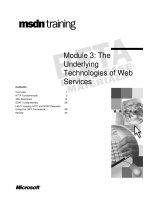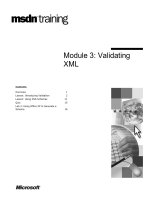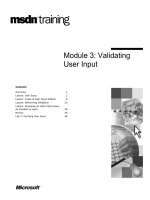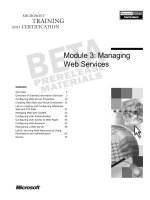Tài liệu Module 3: Microsoft .NET Enterprise Servers, Framework, and Development Tools doc
Bạn đang xem bản rút gọn của tài liệu. Xem và tải ngay bản đầy đủ của tài liệu tại đây (1.52 MB, 38 trang )
Contents
Overview 1
Overview of the .NET Enterprise Servers 2
Overview of the .NET Framework 21
The .NET Framework SDK 30
Review 32
Module 3: Microsoft
.NET Enterprise
Servers, Framework,
and Development Tools
Information in this document is subject to change without notice. The names of companies,
products, people, characters, and/or data mentioned herein are fictitious and are in no way intended
to represent any real individual, company, product, or event, unless otherwise noted. Complying
with all applicable copyright laws is the responsibility of the user. No part of this document may
be reproduced or transmitted in any form or by any means, electronic or mechanical, for any
purpose, without the express written permission of Microsoft Corporation. If, however, your only
means of access is electronic, permission to print one copy is hereby granted.
Microsoft may have patents, patent applications, trademarks, copyrights, or other intellectual
property rights covering subject matter in this document. Except as expressly provided in any
written license agreement from Microsoft, the furnishing of this document does not give you any
license to these patents, trademarks, copyrights, or other intellectual property.
2001 Microsoft Corporation. All rights reserved.
Microsoft, BizTalk, FoxPro, Jscript, Outlook, Visual Basic, Visual C#, Visual C++,
Visual Studio, and Windows are either registered trademarks or trademarks of Microsoft
Corporation in the U.S.A. and/or other countries.
Other product and company names mentioned herein may be the trademarks of their respective
owners.
Module 3: Microsoft .NET Enterprise Servers, Framework, and Development Tools iii
Instructor Notes
This module provides students with an overview of the Microsoft
®
.NET
Enterprise Servers, the Microsoft .NET Framework, and the .NET development
tools.
After completing this module, students will be able to:
Identify the role of each of the .NET Enterprise Servers in e-business
solutions.
Describe the .NET Framework.
Identify the role of Web Services.
Describe the .NET Framework software development kit (SDK)
components.
Materials and Preparation
This section provides the materials and preparation tasks that you need to teach
this module.
Required Materials
To teach this module, you need the following materials:
Microsoft PowerPoint
®
file 2260A_03.ppt
Module 3, “Microsoft .NET Enterprise Servers, Framework, and
Development Tools”
Animation “Introduction to .NET Server Interoperability” in file
2260A_03A005.avi
Animation “Web Services Execution Model” in file 2260A_03A010.exe
Preparation Tasks
To prepare for this module, you should:
Read all of the materials for this module.
View the animations.
Presentation:
85 Minutes
Lab:
00 Minutes
iv Module 3: Microsoft .NET Enterprise Servers, Framework, and Development Tools
Multimedia Presentation
This section provides multimedia presentation procedures that do not fit in the
margin notes or are not appropriate for the student notes.
Web Services Execution Model
Present the animation titled “Web Services Execution Model” by using the
instructions provided in the following table.
Action Say this
There are two ways of calling a Web Service: directly
from the browser or by using a proxy client. This
animation demonstrates these two ways of calling a Web
Service.
Click Direct Client To access a Web Service directly from a browser, the
client simply specifies the Uniform Resource Locator
(URL) to the Web Service (.asmx file). The protocol used
here is Hypertext Transfer Protocol (HTTP).
After processing the request, the server returns a
description page to the client that lists all of the available
methods of the Web Service requested by the client.
After the client discovers the methods of the Web
Service, it invokes a particular Web Service method.
The server processes the request and returns the data to
the client in the Extensible Markup Language (XML)
format.
Click Proxy Client Another method of calling a Web Service is to use a
proxy client. In this method, the client issues a request to
the server for a Web Service. The request is in the form
of an .aspx page.
On receiving the request from the client, the server parses
and compiles the .aspx page.
The server then invokes the proxy (which is instantiated
in the .aspx page) to call the Web Service. The protocol
used here is XML Protocol (XMLP). XMLP was
formerly known as Simple Object Access Protocol
(SOAP).
The response is then sent back to the client in a format
that the client .aspx page can use. The proxy carries out
the data translation.
Module 3: Microsoft .NET Enterprise Servers, Framework, and Development Tools v
Module Strategy
Use the following strategy to present this module:
Overview of the .NET Enterprise Servers
Introduce the concept of the .NET enterprise-level servers from Microsoft.
Discuss the role of each product as described in the module, but remember
to stress the importance of the functions with respect to e-business
applications.
Focus on only the features described in the module—each product provides
many more features, but the ones covered in this module are the important
ones for describing the role of each product in e-business .NET solutions.
Overview of the .NET Framework
Focus on the Web Services and ASP.NET at an overview level. Ensure that
the students understand that they will develop their e-business applications
to take advantage of many of the features in the .NET Framework.
Use the information on Web Services, ADO.NET, and ASP.NET to
familiarize the students with these technologies and help them understand
how these technologies can be used in an e-business solution. Do not delve
into the details of any of the topics in this section because these topics are
covered in greater detail later in this course.
The .NET Framework SDK
Discuss each of the features of the SDK as outlined in this section. Ensure
that the students know where they can download the SDK from. Also, note
that at the time of this writing, the SDK was in the beta version. Find out
whether this is still the case before delivering this module.
Module 3: Microsoft .NET Enterprise Servers, Framework, and Development Tools 1
Overview
Overview of the .NET Enterprise Servers
Overview of the .NET Framework
The .NET Framework SDK
*****************************I
LLEGAL FOR
N
ON
-T
RAINER
U
SE
*****************************
In this module, you will be introduced to the new Microsoft
®
.NET Enterprise
Servers. You will see how each of the servers contributes to the implementation
of business-to-consumer (B2C) and business-to-business (B2B) e-commerce
solutions.
You will also learn about the Microsoft .NET Framework, including ASP.NET
and Web Services. Finally, the module provides an overview of the .NET
Framework software development kit (SDK), which provides the tools for
building .NET applications.
After completing this module, you will be able to:
Identify the role of each of the .NET Enterprise Servers in e-business
solutions.
Describe the .NET Framework.
Identify the role of Web Services.
Describe the .NET Framework SDK components.
Topic Objective
To provide an overview of
the module topics and
objectives.
Lead-in
In this module, you will learn
about the Microsoft .NET
Enterprise Servers,
Framework, and
development tools.
2 Module 3: Microsoft .NET Enterprise Servers, Framework, and Development Tools
Overview of the .NET Enterprise Servers
Multimedia: Introduction to .NET Server Interoperability
Internet Security and Acceleration Server 2000
Application Center 2000
Commerce Server 2000
SQL Server 2000
BizTalk Server 2000
Exchange 2000 Server
Host Integration Server 2000
Mobile Information 2001 Server
*****************************I
LLEGAL FOR
N
ON
-T
RAINER
U
SE
*****************************
The .NET Enterprise Servers work together to provide the infrastructure and
full functionality for your e-business solutions. As such, each of the .NET
Enterprise Servers plays a specific role in e-business solutions.
The .NET Enterprise Servers consist of:
Microsoft Internet Security and Acceleration (ISA) Server 2000
Microsoft Application Center 2000
Microsoft Commerce Server 2000
Microsoft SQL Server
™
2000
Microsoft BizTalk
™
Server 2000
Microsoft Exchange 2000 Server
Microsoft Host Integration Server 2000
Microsoft Mobile Information 2001 Server
In this module, you will learn about the features of the .NET Enterprise Servers
and where they fit in to your e-business solutions.
Topic Objective
To introduce the topics in
this section.
Lead-in
In this section, we will
overview the .NET
Enterprise Servers, which
can be incorporated into e-
business solutions.
Module 3: Microsoft .NET Enterprise Servers, Framework, and Development Tools 3
Multimedia: Introduction to .NET Server Interoperability
*****************************I
LLEGAL FOR
N
ON
-T
RAINER
U
SE
*****************************
To see an animation on how the .NET Enterprise Servers interoperate with each
other to provide an infrastructure for your e-business solutions, run the
Introduction to .NET Server Interoperability media element on the Student
Materials compact disc.
The key point that the animation illustrates is the role of each of the .NET
Enterprise Servers in the context of an e-business infrastructure around which
you will build your e-business solutions.
The key roles played by each .NET Enterprise Server are summarized as
follows:
ISA Server 2000 provides a secure, optimized gateway between your
company’s network and the Internet.
Application Center 2000 provides management and scalability for your
e-business applications.
Commerce Server 2000 provides B2C functionality and in-depth analysis
features for your e-business data.
SQL Server 2000 provides the Web-enabled, high performance Relational
Database Management System (RDBMS) needed by your e-business
applications for data storage and management.
BizTalk Server 2000 provides Extensible Markup Language (XML) data
manipulation capabilities, in addition to integration with your trading
partners’ systems.
Exchange 2000 Server provides messaging and collaborative support for
your e-business solutions.
Host Integration Server 2000 provides mainframe and AS/400 connectivity
for your Microsoft Windows
®
-based servers and applications.
Topic Objective
To describe how the .NET
Enterprise Servers
interoperate with each other
to provide an infrastructure
for your e-business
solutions.
Lead-in
In this animation, you will
see how the .NET
Enterprise Servers
interoperate with each other
to provide an infrastructure
for your e-business
solutions.
Delivery Tip
Play the animation
2260A_03A005.avi on the
Student Materials compact
disc.
4 Module 3: Microsoft .NET Enterprise Servers, Framework, and Development Tools
Internet Security and Acceleration Server 2000
Next Step in the Evolution of Microsoft Proxy Server 2.0
Secure Internet Connectivity
Provides firewall protection at the circuit, packet, and
application levels
Allows access to a VPN by integrating with Windows 2000
Prevents unauthorized access to your networks by
applying security templates to your operating system
Fast Web Access
Provides high performance caching of Web pages
Schedules the download of content
*****************************I
LLEGAL FOR
N
ON
-T
RAINER
U
SE
*****************************
ISA Server 2000 works together with Internet Information Services (IIS) Web
servers to provide access to the Internet.
ISA Server is the next step in the evolution of Microsoft Proxy Server 2.0.
You can use ISA Server to provide secure, reliable, and high-performance
access to your e-business solutions for both your trading partners in your B2B
solutions and your customers in your B2C applications. In addition, you can use
ISA Server to provide Internet access to your employees.
Secure Internet Connectivity
The security and firewall features of the ISA Server provide a manageable and
secure mechanism for allowing customers and trading partners to access your
e-business solutions.
ISA Server:
Provides firewall protection at the circuit, packet, and application levels.The
firewall capabilities allow you to screen Internet traffic not only at the
circuit and packet level, but also at the application level. This allows you to
secure your Internet gateway for use by only approved applications.
Allows access to a virtual private network (VPN) by integrating with
Windows 2000.
Your trading partners can access your B2B application functionality through
the secure remote access functionality of a Windows 2000 VPN.
Topic Objective
To discuss the role of the
ISA Server 2000 in
e-business.
Lead-in
ISA Server is Microsoft’s
new enterprise firewall and
Web caching server built for
Windows 2000 Server.
Delivery Tip
Focus your delivery on ISA
Server in the context of
e-business solutions.
Features that enhance
e-business solutions are
more important for this
module than specific
technical details.
Module 3: Microsoft .NET Enterprise Servers, Framework, and Development Tools 5
Prevents unauthorized access to a network by applying security templates to
your operating system.ISA Server provides protection against unauthorized
access and hacker attacks. ISA Server and Windows 2000 work together to
lock down your system and network against unauthorized access. This is
easily achieved by the application of pre-defined security templates to your
operating system.
Common network attacks, such as port scanning, can be identified and
responded to in order to help prevent hacker attacks.
Fast Web Access
Apart from providing security, the ISA Server also provides caching
mechanisms and scheduled download features to accelerate the performance of
your e-business solutions.
ISA Server:
Provides high performance caching of Web pages.
It implements fast random access memory (RAM) caching of Web pages
that can be served to the browser directly. In addition to the RAM cache,
ISA Server also implements a highly optimized disk cache for Web pages,
thereby providing more storage capacity for the caching engine of the
server.
Schedules downloading of content.
In a scenario in which your e-business solution has multiple servers
participating in the caching and optimization of performance, ISA Server
allows you to distribute content between the servers and then pre-load the
cache. You can easily manage both the distribution of content and pre-
loading of the cache on each ISA Server by setting up a schedule for these
actions.
The cache engine of ISA Server is also fully programmable through the caching
application programming interface (API). This API allows you to write
additional performance-enhancing utilities as part of your e-business solution.
You will learn more about caching in ISA Server in Module 4,
“Designing the Client Experience,” in Course 2260A, Designing E-Business
Applications with Microsoft .NET Enterprise Servers.
Note
6 Module 3: Microsoft .NET Enterprise Servers, Framework, and Development Tools
Application Center 2000
Application Management
Reduces management complexity by presenting an
application as a single entity
Synchronizes application over the servers in a cluster
Software Scalability
Application load balancing and fault tolerance: hardware
and software clustering
NLB and COM+ component load balancing
Mission-Critical Availability
Unlimited (24X7) availability of Web applications
*****************************I
LLEGAL FOR
N
ON
-T
RAINER
U
SE
*****************************
Application Center 2000 provides application management, application
scalability, and application availability features. These features enable both
administrators and developers to develop, deploy, and operate scalable, reliable
applications, without requiring them to have in-depth knowledge of the
functioning of the application in a high-availability and scalable environment.
Although this applies to traditional line-of-business applications that your
enterprise may develop, it also holds true for your B2C and B2B e-commerce
applications.
Application Management
Your Web-based e-business solutions are likely to be implemented on a high-
performance, distributed application architecture. The fact that many different
computers house many different layers and components can present challenges
for both the developers and the administrators of your e-business solution.
Application Center 2000:
Reduces management complexity.
It presents your entire application as a single entity, thereby reducing the
complexity involved with distributed e-business solutions.
Synchronizes application over the servers in a cluster.
In addition to designing multiple layers in your application architecture, you
can also implement your solution in a clustered environment. Application
Center 2000 enables the synchronization of configuration settings between
all machines in a cluster, thereby allowing you to easily keep your content
and settings consistent across all the machines in a cluster.
Topic Objective
To discuss the role of
Application Center 2000 in
e-business.
Lead-in
Application Center 2000 can
be used to simplify the
management and
monitoring of large,
clustered applications.
Delivery Tip
Focus your delivery on
Application Center 2000 in
the context of e-business
solutions. Features that
enhance e-business
solutions are more important
for this module than specific
technical details.
Module 3: Microsoft .NET Enterprise Servers, Framework, and Development Tools 7
Software Scalability
Clustering together multiple application servers has been a popular approach to
increasing both application scalability and application reliability in recent years.
Clustering allows for application load balancing and fault tolerance.
Application servers that are clustered appear as a single unit to client machines
and administrators alike. There are two types of clustering you can use to
achieve these benefits:
Hardware clustering
Hardware clustering involves specialized servers and cluster controllers to
provide the clustering functionality. This tends to be an expensive solution
when compared to software clustering.
Software clustering
The software-clustering capability of Application Center 2000 provides the
traditional clustering benefits while being a much more cost-effective
solution.
Application Center 2000 software clustering integrates with Windows 2000
Network Load Balancing (NLB). NLB provides a way to configure several
physical machines to appear to clients as one logical server. Windows 2000
incoming requests are directed to an Internet Protocol (IP) address that
identifies this virtual server and the NLB service distributes the requests
evenly among the actual physical servers in the cluster. Because the service
runs on each member of the cluster, there is no single point of failure, and if
one member of the cluster becomes unavailable, the requests are distributed
among the remaining servers.
In addition, Application Center 2000 software clustering integrates with
COM+ component load balancing, thereby allowing the distribution of
component execution across multiple servers. The advantages of component
load balancing for distributed computing are similar to that of the NLB.
However, it is not simply a matter of redirecting incoming requests to
available members of the cluster, but rather the distribution of object
instances across the network to make the best use of available processing
power.
Mission-Critical Availability
Application Center 2000 is designed such that any single server can be taken
offline, either for maintenance or when caused by a power outage, without
affecting the availability of the e-business solution functionality to the client.
The effect of this is that your e-business solutions can have 24x7 (unlimited)
availability by using standard off-the-shelf servers. The 24x7 availability
concept is of utmost importance for your e-business solution.
You must aim to provide access to your e-business solutions at any time for
both your customers and trading partners because they may be in different time
zones than yours. This mission-critical availability is easily attained by using
Application Center 2000, while also reducing your implementation and running
costs at the same time.
Delivery Tip
Emphasize that Application
Center 2000 integrates with
Windows 2000 software
clustering.
8 Module 3: Microsoft .NET Enterprise Servers, Framework, and Development Tools
Commerce Server 2000
Business Pipelines
Control the flow of transactions
Order processing pipeline for B2C applications
Catalogs
Support product search capabilities
Customization of catalogs
Profile System
Creates and extends profiles (data definitions for business
entities)
Business Analysis
Includes tools that allow business managers to base their
decisions on appropriate data aggregations
*****************************I
LLEGAL FOR
N
ON
-T
RAINER
U
SE
*****************************
Commerce Server 2000 provides e-business site developers an advantage by
providing a rapid application development tool for site building. It also includes
sophisticated business analysis tools that can be used to uncover business
opportunities and refine online business promotions.
Commerce Server 2000 is a powerful, online business-processing server. It
includes:
Transaction-processing capabilities
Commerce Server 2000 can be used in your e-business solution to control
the business processes and transactions for both your B2C and B2B
applications.
Product catalog management
Commerce Server 2000 implements Commerce Server Business Desk, a
management tool to support up-sell and cross-sell promotions.
Analysis features
Analysis features integrate with Microsoft SQL Server 2000 Analysis
Services, formerly known as Microsoft Online Analytical Processing
(OLAP) Server 1.0, to support your business managers' strategic decision-
making.
Topic Objective
To discuss the role of
Commerce Server 2000 in
e-business.
Lead-in
Commerce Server 2000
provides e-business site
developers many
advantages by providing a
rapid application
development tool for site
building.
Delivery Tip
Focus your delivery on
Commerce Server 2000 in
the context of e-business
solutions. Features that
enhance e-business
solutions are more important
for this module than specific
technical details.
Module 3: Microsoft .NET Enterprise Servers, Framework, and Development Tools 9
Business Pipelines
Commerce Server 2000 includes customizable order processing pipelines (OPP)
for B2C applications.
The pipelines control the flow of transactions for your customer-purchase
operations. You can customize the pipelines to add your own stages to the
business process or to modify the functionality and sequence of the existing
stages.
OPP is part of Commerce Server 2000; however, commerce interchange
pipelines (CIP), which were available in the earlier versions of Commerce
Server, are not present in Commerce Server 2000. BizTalk Server 2000
includes tools that enable commerce interchange.
Catalogs
The catalog functionality of Commerce Server 2000 allows you to implement
effective management systems for millions of products and services.
Commerce Server supports product search capabilities. Customers can find
product information easily and efficiently with the help of catalogs. Commerce
Server 2000 translates any catalog-related query it receives to a database query,
which it will then issue against the RDBMS.
Customization of catalogs
It is likely that you need to categorize products into some sort of hierarchy that
reflects the relationship between products. The Commerce Server 2000 catalog
system allows you to define such hierarchies and design your own categories.
This means that you can completely customize the catalog system to match the
products and services that you provide to your customers and trading partners.
Profile System
Commerce Server 2000 includes a profiling system for handling different
categories and profiles of your customers and trading partners. Profiles are data
definitions for common business entities. Commonly profiled entities include:
Users
Organizations
Purchase orders
Requisitions
Products
Accounts
Profiles are easily created and extended by using the Microsoft Management
Console (MMC) snap-in for Commerce Server 2000. Profiled entities can be
aggregated across multiple stores, thereby allowing you to define the profiled
object once for your e-business application. Profile attributes can be stored in
any of several data stores and then presented to the application as a single
profile object. Commerce Server 2000 Profile System has out-of-box support
for the Active Directory
™
directory service in Windows 2000 and SQL Server
definition storage. Other stores, such as DB2 and Oracle, can be implemented
using the Commerce Server 2000 SDK.
Delivery Tip
Explain the concept of
pipeline diagrammatically.
Note









